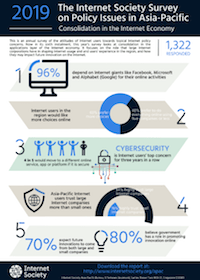The Week in Internet News: IoT Devices Could Put Privacy at Risk, Study Says

A real privacy headache: Internet of Things devices potentially expose consumer information to other parties, according to a recent study featured on Vice.com. Many IoT devices collect and share a wealth of information including the IP address, usage habits, and location data. That data is then often shared with “a laundry list” of third parties.
Encryption objections: ISP trade groups are objecting to a plan by Google to a new encryption regime for domain name lookups in its Chrome browser and Android operating system, Broadcasting and Cable reports. The plan would give Google too much power, the groups have told U.S. lawmakers.
Moving to the country: Microsoft and Nextlink Internet have unveiled a plan to bring broadband to millions of people living in the rural U.S., WindowsCenteral.com says. The Microsoft Airband Initiative’s goal is to extend broadband access to more than 3 million unserved U.S. residents by mid-2022, with more areas covered by 2024.
The FBI wants in: The U.S. FBI tried to get the operators of encrypted phone carrier Phantom Secure to create a backdoor, as a way to spy on the Sinaloa drug cartel, Vice.com reports. The company was accused Continue reading
IBM’s journey to tens of thousands of production Kubernetes clusters
IBM Cloud has made a massive shift to Kubernetes. From an initial plan for a hosted Kubernetes public cloud offering it has snowballed to tens of thousands of production Kubernetes clusters running across more than 60 data centers around the globe, hosting 90% of the PaaS and SaaS services offered by IBM Cloud.
I spoke with Dan Berg, IBM Distinguished Engineer, to find out more about their journey, what triggered such a significant shift, and what they learned along the way.
So take me back to the beginning – how did this thing get started?
It must have been 3 years ago. At that time, IBM had been building customer-facing services in the cloud for several years implemented as traditional VM or Cloud Foundry workloads. One of the services we offered was a container as a service (CaaS) platform that was built under the covers using Docker and OpenStack. With this platform, we were the first in the industry to provide a true CaaS experience, but in some ways it was ahead of its time, and people weren’t ready to embrace a pure container as a service platform.
To this day we are still seeing double digit Continue reading
Stateless’ Software-Defined Interconnect Battles NFV, SD-WAN
The startup says “five of the top five” cloud and colocation service providers are testing its...
Next-Generation Reference Design Guide for NSX-T
The NSX-T 2.5 release marks a cornerstone in NSX-T as announced at VMworld 2019 by SVP Umesh Mahajan. 2019 has been a year of phenomenal growth for VMware’s NSX-T with its wide adoption by enterprises across several verticals. In 2019, we introduced two ground-breaking releases NSX-T 2.4 and NSX-T 2.5. With these two releases, we are fully embarking on enterprise ready system becoming the de-facto enterprise software-defined networking (SDN) platform of choice.
To support our customers in their network and security virtualization journey, we introduced the NSX-T design guide on the NSX-T 2.0 release and provided design guidance on how customers should design their data centers with NSX-T.
Today, we are excited to announce the next version of the NSX-T design guide based on generally available NSX-T release 2.5. It is the foundation overhaul to design guidance and leading best practices. There have been numerous L2-L7 features additions and platform enhancements since NSX-T release 2.0. This design guide covers functional aspects of these enhancements and provides design guidance for them.
What readers can expect in the new NSX-T Design Guide:
- Packet walks
- Detailed explanation of Continue reading
NeoPhotonics Points Lasers, AWG Multiplexers at Data Centers
The new lasers and the line of arrayed waveguide grating multiplexers are designed to bolster...
Ericsson Expands US Manufacturing With New Factory in Texas
The 300,000-square-foot factory will begin commercial operations early next year in Lewisville,...
CNTT’s Initial NFVi Release Targets OpenStack
The group is working with service providers to define and create VNF reference architectures for...
VMware NSX Achieves FIPS 140-2 Validation
Co-authored with Rajiv Prithvi, Product Manager Networking and Security Business Unit at VMware
During VMworld US 2019, we announced several new transformative capabilities in VMware NSX-T 2.5 release which is now shipping! The release strengthens the NSX platform’s intrinsic security, multi-cloud, container, and operational capabilities.
We also announced the successful FIPS 140-2 validation of NSX-T 2.5. FIPS compliance is mandatory for US federal agencies and has also been widely adopted in non-governmental sectors (e.g. financial services, utilities, healthcare). FIPS-140-2 establishes the integrity of cryptographic modules in use through validation testing done by NIST and CSE. With this validation, we further deliver on our confidentiality, integrity and availability objectives and provide our customers with a robust networking and security virtualization platform.
Compliance-Based Configuration with NSX-T 2.5
NSX-T 2.5 is configured to operate in FIPS mode by default. Any exceptions or deviations from established compliance norms are identified in a compliance report which can be used to review and configure your NSX-T Data Center environment to meet your IT policies and industry standards. Any exceptions to FIPS compliance including configuration errors can be retrieved from the compliance report using NSX Manager UI or APIs.
A sample FIPS Continue reading
Network Break 253: Arista CloudVision Ingests Configs From Third-Party Gear; Cisco Adds Azure To Cloud ACI
Today's Network Break discusses upgrades to Arista's CloudVision management software, a new ACI partnership between Cisco and Microsoft Azure, a Google pledge to invest in new European data centers, Amazon's pledge to be carbon-neutral by 2040, and more tech news.
The post Network Break 253: Arista CloudVision Ingests Configs From Third-Party Gear; Cisco Adds Azure To Cloud ACI appeared first on Packet Pushers.
Network Break 253: Arista CloudVision Ingests Configs From Third-Party Gear; Cisco Adds Azure To Cloud ACI
Today's Network Break discusses upgrades to Arista's CloudVision management software, a new ACI partnership between Cisco and Microsoft Azure, a Google pledge to invest in new European data centers, Amazon's pledge to be carbon-neutral by 2040, and more tech news.APAC Policy Survey 2019: Consolidation in the Internet Economy

The Internet is changing. Consolidation in the Internet economy, the topic of the Global Internet Report 2019, might be the source of ongoing shifts in its underlying infrastructure and the way users engage, among many other things.
Clearly, the growing presence of big Internet platforms can benefit the user by offering seamless Internet experiences, but it could also harm innovation, competition, and the Internet’s broader architecture, says the report, which marks the start of the Internet Society’s efforts to examine this issue.
The Internet in Asia-Pacific is no exception. A few corporations – including Facebook and Tencent in social networking, Google and Baidu in search, and Amazon and Alibaba in online shopping – dominate large parts of the Internet, benefitting people while raising similar questions about what it means for the Internet’s fundamental properties.
This year’s Survey on Policy Issues in Asia-Pacific, released today, helps deepen our understanding of the role that corporations play in shaping Internet use and user experience in the region and how they may impact future innovation on the Internet.
More than 1,300 people from 39 economies in the region took our online survey when we opened it to the public in July.
The Continue reading
Juniper NXTWORK Hack-a-Thon
Over the past couple of years, Juniper has hosted a Hackathon at start of NXTWORK. This event is a great …
The post Juniper NXTWORK Hack-a-Thon appeared first on Fryguy's Blog.
Cleaning up bad bots (and the climate)

From the very beginning Cloudflare has been stopping malicious bots from scraping websites, or misusing APIs. Over time we’ve improved our bot detection methods and deployed large machine learning models that are able to distinguish real traffic (be it from humans or apps) from malicious bots. We’ve also built a large catalog of good bots to detect things like helpful indexing by search engines.
But it’s not enough. Malicious bots continue to be a problem on the Internet and we’ve decided to fight back. From today customers have the option of enabling “bot fight mode” in their Cloudflare Dashboard.

Once enabled, when we detect a bad bot, we will do three things: (1) we’re going to disincentivize the bot maker economically by tarpitting them, including requiring them to solve a computationally intensive challenge that will require more of their bot’s CPU; (2) for Bandwidth Alliance partners, we’re going to hand the IP of the bot to the partner and get the bot kicked offline; and (3) we’re going to plant trees to make up for the bot’s carbon cost.

Malicious bots harm legitimate web publishers and applications, hurt hosting providers by misusing resources, and they doubly hurt the planet Continue reading
Cisco ACI – Configuring by POSTing JSON
If you are configuring Cisco ACI datacenter fabric it will sooner or later get to the point that you need to configure multiple objects inside the GUI which will, by using the click-n-click method, take a huge amount of time. While using POSTMAN to create multiple objects of the same type is the preferred method that everybody is speaking about (because you can generate REST API calls using Python or something similar), the quickest way to do it is using POST of JSON configuration file directly through the GUI. POSTing JSON config example As described above, the POST of JSON
The post Cisco ACI – Configuring by POSTing JSON appeared first on How Does Internet Work.
Infinera Unveils XR Optics, Aims To Simplify Metro Networks
The transportation methodology aims to simplify metro networks, reduce capital expenditures, and...
Just Published: Network Services Integration in EVPN Fabrics
In last week’s continuation of EVPN never-ending story Lukas Krattiger described how you could use EVPN constructs (VNIs, VRFs) to implement service insertion, and how you could combine then with policy-based routing.
TL&DW: It’s bridging and routing ;)
You’ll need Standard ipSpace Subscription to access the videos.
DNS Resolver Centrality
Moving the DNS from the access ISP to the browser may not necessarily enhance open competition in the DNS world. In today's Internet just two browsers, Chrome and Safari dominate the browser world with an estimated 80% share of all users. If the DNS becomes a browser-specific setting, then what would that mean for the DNS resolver market? And why should we care? It would be useful to understand what is going on in the DNS today, before there has been any major shift to adopt DoH or DoT by high-use applications such as browsers. Can we measure the level of DNS centrality in the Internet today?Welcome to Birthday Week 2019


September has always been a special month for Cloudflare. Nine years ago — on September 27th — we launched Cloudflare. And, each year since, we’ve celebrated our birthday with a week full of new products and innovations that support our mission of helping to build a better Internet.
Our mission guides everything we do. One of the most intentional words in our mission is ‘helping’. Building an Internet that can meet the world’s needs cannot be done by any one company or individual; rather, it takes a global community — from nonprofit organizations and businesses to governments and individuals — collaborating to deliver new standards, technologies, and innovations. We believe Cloudflare should be an active participant in the community and help where we can and should.
Our customers and partners are an active part of the community. I often say that customers are one of my favorite parts of my job (our team is my other favorite part). Our customers give us feedback all the time about what they'd like to see to make their Internet properties more secure, more performant and more reliable. Our partners bring forward standards to help make the Internet run more smoothly. For Birthday Week Continue reading
